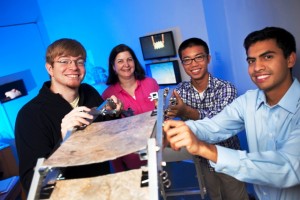By Sean Grim ’14
What do an ancient Chinese lute, engineering design software, and the Japanese art of origami have in common?

Michael Hezel ’14, l-r, Professor Anne Raich, Jason Sheng ’15, and Eduardo Rodriguez ’14 with the scissor-element truss-arch
The link is Zhe “Jason” Sheng ’15 (Dalian, China), a double major in mechanical engineering and music. Through Lafayette’s START initiative and EXCEL Scholars undergraduate research program, Sheng is working with Anne Raich, associate professor of civil engineering. Together they are researching the feasibility of “deployable structures,” founded on the principles of origami. In effect, Raich and Sheng are creating folding metal devices, which collapse and expand while maintaining structural integrity.
Funded by a grant from the Mellon Foundation, the START initiative (“it STarts with ART”) is a multi-year project to integrate the arts across the College curriculum. This fall, START is focusing on the scientific and engineering applications of origami, the Japanese art of paper folding.
“The primary design issue in our research involves how to take designs that work well with very thin materials, such as paper, and try to make these designs work with thicker materials, such as plastic or metal,” says Raich. “Paper can be folded over itself many times, while plastic can be folded once, maybe twice, before element edges bind and pinch and refuse to move.”
Raich, along with previous EXCEL Scholars, conceptualized two structures: a “folded plate” and a “scissor-element truss-arch.” Last year, Raich and her students completed the theoretical designs for these objects. With the calculations finalized, Raich enlisted Sheng to design digital models of the structures using the mechanical engineering software Inventor.
Last year, Sheng used the software in EXCEL Scholars research with Ingrid Furniss, assistant professor of art, on the Silk Road as a cultural artery. Furniss’ scholarship focuses on the ruan, a Chinese lute, which she argues was integral to the cultural exchange along the trade route. As a complement to her written work, Furniss sought to create an interactive digital model of the lute.
With Raich, Sheng drafted prototypes for the folded plate and scissor-element truss-arch. In conjunction with Sheng’s digital simulations, physical models of the structures were constructed by civil engineering majors Michael Hezel ’14 (Phillipsburg, N.J.) and Eduardo Rodriguez ’14 (Santa Tecla, El Salvador).
The scissor truss model and videos of Sheng’s simulations were included in the Crease, Fold & Bend exhibition in the Williams Center Gallery. The exhibit, which was part of the START initiative, was a celebration of origami and its applications in science, mathematics, technology, engineering, and the visual arts.
Sheng’s research is one part of Raich’s larger project in deployable structure design. Her objective is to create reusable structures that provide for ease of transportation and installation. Reversing the mechanisms of origami, the compact objects can be unfolded into larger, stable structures.
“Deployable structures can provide temporary emergency housing, as well as provide movable, temporary roofs for exhibition venues and sporting events,” says Raich. “In these applications, deployable structures must be designed to withstand wind or earthquake loads.”
After graduation, Sheng plans to pursue a master’s degree in mechanical engineering. He relishes research projects that give him the chance to “apply what I learn in the classroom, and to feel like I am improving the world.”
Sheng continues to develop his interests in the arts and in global affairs, actively participating in student organizations. He is a member of the Concert Choir, the Percussion Ensemble, and “The Truth,” an R&B a cappella group. He is a former officer of the International Students Association.

1 Comment
Great job, Eduardo and team!
Comments are closed.